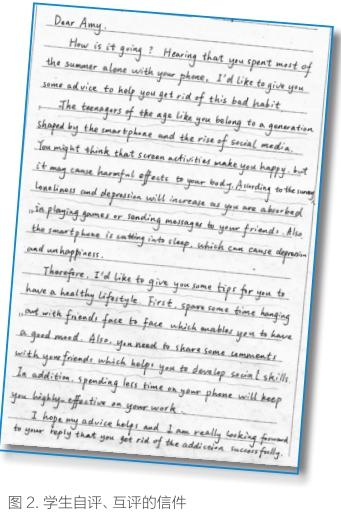基于引领性问题探究主题意义,发展英语学科核心素养的主题教学探索
赵冉 刘燕
摘 要:教师设计的引领性问题,即从理解到应用、从分析到评价等有层次的课堂提问,是组织学生探究主题意义的必要环节,也是发展学生英语学科核心素养的重要途径。本文通过一则教学课例,展示了教师如何围绕主题意义进行教学探索,即如何通过引领性问题的设置培养学生的思维能力、合作能力和探究能力。
关键词:主题意义探究;英语学科核心素养;引领性问题
引言
《普通高中英语课程标准(2017年版)》(以下简称 《课标》)提出了发展英语学科核心素养,落实立德树人根本任务的基本理念。英语学科核心素养包括语言能力、文化意识、思维品质和学习能力。《课标》在课程实施建议中指出,教师应关注主题意义,制订指向核心素养发展的整体教学目标;深入研读语篇,把握主题意义,落实英语学科核心素养目标,创设合理的学习活动;实践英语学习活动观,引导学生加深对主题意义的理解,促进核心素养的有效形成(中华人民共和国教育部,2018)。“有效的英语课堂是在教师的引导下,以问题为导向,师生共同对主题意义展开的探究”(梅德明,王蔷,2018)。笔者将以一次主题教学实践为案例,探索如何基于引领性问题,即通过从理解到应用、从分析到评价等有层次的课堂提问,引导学生开展主题意义探究,在学习理解、应用实践、迁移创新的活动中,发展培养学生的英语学科核心素养。
教学分析
1. 内容分析
中学生普遍使用智能手机,但多数人并没有意识到过度使用手机会引发心理危机,其危害将对青少年产生长远影响。教学文本Have Smartphones Destroyed a Generation?聚焦手机及青少年心理健康。在“人与自我”的主题语境下,关注健康的生活方式、积极的生活态度。通过课外读物节选和短对话视频等多模态语篇,呈现手机引发的青少年心理危机(以下简称危机)、危机的具体表现形式和长远危害,以及化解危机的可能性。其中,短对话视频呈现母子对手机引发危机的探讨,主体语篇节选自课外读物(见附文)。在这篇长达八百余字的议论文中,作者基于调查问卷数据和青少年Amy的个案分析,论证了手机引发危机的具体表现、长远危害以及过度使用手机与危机之间的内在关联。
2. 学情分析
学生处在高三年级,已具有概括描述事实、分析表达观点的英语语言能力。学生在生活中普遍使用手机,对手机引发的危机感却缺乏足够重视。因此,教师力图进一步发展学生用英语阐释对语篇的态度和联系语篇内容的语言能力,同时提高学生合理使用手机的意识。
3. 教学目标
通过本主题学习,学生能够整合手机引发危机的具体表现和长远危害,分析手机引发危机的内在关联,提出预防或化解危机的具体措施。
设计思路
教师围绕“智能手机引发当代青少年心理危机”的主题,利用三个课时引导学生从发现问题、分析问题、解决问题三大板块展开主题意义的探究活动。在发现问题板块,学生基于多模态语篇中的视频和主体篇章,探究手机引发危机的具体表现和长远危害。在分析问题板块,学生深入阅读篇章,探究手机引发危机的内在关联。在解决问题板块,学生超越篇章,提出化解或预防危机的具体措施。在发现问题、分析问题、解决问题的学习活动中,教师设计引领性问题,串联主题意义探究环节,培养学生英语学科核心素养。
教学过程
板块一:发现问题
活动1:看图片讨论(见图1)
问题引領:
Is the smartphone locker necessary for students?
学生活动及反馈:学生组内讨论,之后从组内选择代表向全班同学分享观点。有的学生认为,手机保管箱没有必要,因为学生有合理使用手机的自制力。也有的学生表示,使用手机对视力有负面影响,限制使用手机有一定道理。
[设计意图] 在新学期,学校给各班配备了手机保管箱,要求学生在校期间将手机放置在此。教师从校园规则出发,创设情境,激发学生已有的知识和经验,引出探究主题。从学生的表达不难看出,学生使用手机,但对其可能引发的危机没有足够的认识。活动1中的引领性问题从感知注意的层面,驱动学生关注思考问题,引出主题。
活动2:观看对话视频回答问题
问题引领:
Question 1: What are the mother and son talking about in the skit?
Question 2: Do you agree with the mother?
学生活动及反馈:学生观看对话视频,讨论剧中母子谈论的话题。学生记录下母亲的观点:使用手机会引发危机,包括孤独、抑郁、自杀倾向和睡眠问题。但是他们认为这一观点未免夸张。
[设计意图] 多模态语篇中的对话视频以丰富的动作和生动的表情呈现主题,为主题意义探究预热。学生获取梳理视频中提及的危机的具体表现形式,概括整合手机引发危机的事实。活动2提出的第一个问题基于语篇,引领学生学习理解语篇所表达的主题意义和价值取向。第二个问题引导学生分析判断,表达观点。
活动3:初读文本,概括事实信息
问题引领:
Question 1: What negative feelings have you ever experienced?
Question 2: What negative feelings does the generation experience?

[設计意图] 教师在本环节设计的引领性问题“Have smartphones destroyed a generation?”貌似封闭,却是整个主题教学中最具开放性和升华性的问题。确切地说,学生对这个问题的回应,需要调动整个主题意义探究过程中形成的语言知识和文化知识。学生在重读篇章、完善思维导图、设计问题和访谈问答的过程中,联系个人生活,进一步实现语言内化,强化结构性知识,建构主题意义。在访谈活动中,学生理解并表达主题意义,提升了语言能力。在问答对话中体现价值取向,增强了文化意识。学生设计的访谈问题,从思维上由低到高,层层推进,体现出有一定深度的思维水平。在互动交流的合作学习中,调动学习策略,发展学习能力。
活动8:给文本中的案例人物写信
问题引领:
Question 1: What are the mental health risks Amy may face?
Question 2: If you write Amy a letter to help her free from the mental health risks, what would you like to write?
Question 3: How do you comment on your peers letter?
学生活动及反馈:学生重读篇章,概括整合案例人物Amy遭受危机的具体表现,给她写信,解说过度使用手机引发的危机,提出化解危机的具体措施。
[设计意图] 学生完成写作任务,总结主题意义探究。写作前,学生整合分散信息,生成写作任务,讨论制定写作评标,例如信件内容要支撑写作目的,信件语言可借鉴语篇的话语表达等。学生给Amy写信,解释过度使用智能手机的危害,建议她适度使用手机,提出化解危机的具体措施,帮助她化解危害或预防危机。写作后,学生根据评价表(见表)自评、互评作文,体现了学习的主动性。学生自评、互评信件(见图2),培养了学生自主学习、合作学习、探究式学习的学习能力。
活动9:分享收获和反思
问题引领:
Could you please summarize and share what you have gained?
学生活动及反馈:本环节引领学生回顾主题意义探究的内容,引导学生反思使用手机的情况,分享学习收获。一位学生坦诚地说:“Actually, I shared the sad feelings mentioned in the text. I feel bored with the endless moments and messages. I will change some settings, and live a happy life.”。
[设计意图] 本环节的引领性问题引导学生整理归纳学习内容,实践学习策略,发展学习能力。同时,通过联系自身,反思生活习惯,学生将更好地认知自我,从而养成健康的生活方式和积极的生活态度。


小结
本主题教学实践基于学生使用手机的实际问题确立主题意义。围绕主题意义,教师设计紧密相连、由浅入深的引领性问题,引导学生开展探究活动,以听、说、读、看、写等形式,深入思考并概括手机引发心理危机的表现,分析二者的内在关联,并提出了预防危机的措施,从而提高了预防心理危机的意识。引领性问题还引导学生开展合作学习,例如访谈同伴、总结分享,帮助学生在发展学习能力的同时建立积极健康的生活方式。
在今后的教学实践中,笔者还将继续探索如何在其他的主题语境下设计出适切的引领性问题,引导学生开展英语学习活动,探究主题意义,落实并发展核心素养,体现英语学科的育人价值。此外笔者不断钻研的问题还包括如何在主题探究的过程中确保学生的语言内化,进而实现整体产出。
参考文献
梅德明,王蔷. 2018. 改什么?如何教?怎样考?高中英语新课标解析[M].北京: 外语教学与研究出版社.
中华人民共和国教育部. 2018.普通高中英语课程标准(2017年版)[S].北京:人民教育出版社.
赵冉,北京市第二中学英语教师。刘燕,北京市东城区教师研修中心高中英语教研员,东城区英语学科带头人。
附文
Have Smartphones Destroyed a Generation?
Amy, 16 years old, spent most of the summer alone in her room with her phone. She said, “I think we like our phones more than we like actual people.” Young people like Amy belong to a generation shaped by the smartphone and the rise of social media. I call them iGen. Born between 1995 and 2012, they are growing up with smartphones, and have a social media account before they start high school. iGens oldest members were early adolescents when the iPhone was introduced in 2007, and high-school students when the iPad entered the scene in 2010. The arrival of the smartphone has changed their social interactions and their mental health. Its not an exaggeration to describe iGen as being on the brink of the worst mental-health crisis. It can be traced to their phones. The devices weve placed in their hands are making them seriously unhappy. They are on their phone, in their room, alone and distressed.
“Ive seen my friends with their parents—they dont talk to them,” Amy told me. “They just say ‘Ok, whatever while theyre on their phone. They dont pay attention to their family.” Like her peers, Amy is an expert at tuning out her parents so she can focus on her phone to keep up with friends, but nearly all of it was over text. As they spend less time with their friends in person, the number of teens who get together with their friends nearly every day dropped by more than 40 percent from 2000 to 2015; Its not only a matter of fewer kids partying; fewer kids are spending time simply hanging out. The basketball court and the town pool have all been replaced by virtual spaces.
You might expect that teens spend so much time in these new spaces because it makes them happy, but most data suggest that screen activities are linked to unhappiness. The across-year survey designed to be nationally representative asks how happy teens are and how much of their time is spent on non-screen and screen activities. Eighth-graders who spend 10 or more hours a week on social media are 56 percent more likely to say theyre unhappy than those who devote less time to social media. Those who spend an above-average amount of time with their friends in person are 20 percent less likely to say theyre unhappy than those who hang out for a below-average amount of time.
Todays teens may go to fewer parties and spend less time together in person, but when they do congregate(聚集), they post their hangouts relentlessly on social media. Those not invited to come along are keenly aware of it. Accordingly, the number of teens who feel left out has reached all-time highs. Like the increase in loneliness, the upswing in feeling left out has been swift and significant.
Rates of teen depression and suicide have skyrocketed(飆升) since 2011. Eighth-grade heavy users of social media increase their risk of depression by 27 percent, while those who play sports or do homework cut their risk significantly. Teens who spend three hours a day or more on electronic devices are 35 percent more likely to have a risk for suicide, such as making a suicide plan.
The smartphone is also cutting into sleep. National surveys show that teens who visit social-media sites every day are 19 percent more likely to be sleep-deprived. Children who use smartphones right before bed are more likely to sleep less than they should, more likely to sleep poorly, and more than twice as likely to be sleepy during the day. Smartphones could be causing lack of sleep, which leads to depression, or the phones could be causing depression, which leads to lack of sleep.
Smartphones are likely to affect teens well into adulthood. Among people who suffer depression, at least half become depressed again later in life. Adolescence is a key time for developing social skills; as teens spend less time with their friends faceto-face, they have fewer opportunities to practice them. In the future, we may see more adults who know just the right emoji, but not the right facial expression.
I realize that restricting technology might be an unrealistic demand to impose on a generation so accustomed to being wired at all times. In my conversations with teens, I saw hopeful signs that kids themselves are beginning to link some of their troubles to their ever-present phone. Amy told me that when she spends time with her friends in person, they are looking at their device instead of at her. “What does that feel like?” I asked. “It hurts,” she said. Once she was hanging out with a friend who was texting her boyfriend. “I was trying to talk to her about my family, and she was like, ‘Uh-huh, whatever. So I took her phone out of her hands and threw it at the wall.”

